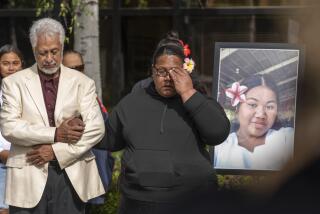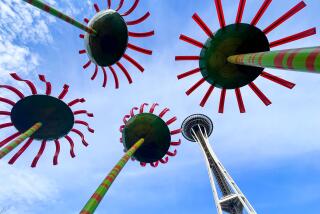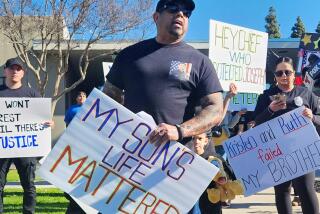Seattle in turmoil over police-involved shootings
Reporting from Seattle — John T. Williams was a fixture in downtown Seattle with his carving knife and blocks of wood, which he fashioned into artful totems characteristic of the DididahtFirst Nation, his Canadian native tribe.
FOR THE RECORD:
Seattle police shootings: An article in the Sept. 17 Section A about police shootings in the Seattle area made reference to a Baptist pastor being shot to death by a sheriff’s deputy. That incident happened in Spokane Valley, in eastern Washington.
He drank heavily and was hard of hearing in one ear, to the point that Williams — known for telling elaborate stories about the characters in his totems — was often incoherent and oblivious, said several of his friends and relatives.
He didn’t drop his 3-inch knife when a Seattle police officer ordered him three times to do so at a crowded downtown intersection on Aug. 30. Did he hear the order? Was he thinking of turning his knife into a weapon? These are questions for which answers may never be known. A little more than a minute after the officer stepped out of his car, Williams lay dying on the sidewalk with four gunshot wounds to the chest.
The case is one of a wave of shootings and beatings involving the Seattle Police Department, prompting widespread public demand for a rethinking on the use-of-force policies and policing in minority communities, particularly one of its biggest and least understood, Native Americans.
Newly installed Chief John Diaz this week announced a top-end overhaul to ramp up training and reemphasize community relations in a department that recently earned national praise for its neighborhood policing.
“We have lost some of that through the years, that sense of connection, the social fabric that keeps all of us together,” Diaz said this week. “We really are talking about building peace in every one of those contacts. We can’t get them right 99% of the time. We have to try to get them right 100% of the time.”
Lately, the average hasn’t been close.
In April, Seattle police made national headlines with a video of a gang detective stomping a Latino man who was prone on a sidewalk and warning that he was going to “beat the … Mexican piss out of you, homey. You feel me?”
In June, another video emerged. This time, an officer was seen punching a 17-year-old African American girl in the face when she intervened in the arrest of her girlfriend for jaywalking.
The worst string of violence began in August, with three officer-involved shootings in three weeks. During the same period, a knife-wielding man was shot to death by police in neighboring Tacoma and a 74-year-old Baptist pastor investigating a noise in the nursery next to his home late at night was shot to death by a sheriff’s deputy after he allegedly moved to pull out a gun.
Diaz said he would ask two outside police departments to independently review the Williams inquiry once it was completed.
“This incident raises, as do other incidents in the past, very serious concerns about the preparation of our officers and concerns about racial profiling within the department,” said Mayor Mike McGinn. “The can of worms is open.”
Williams was shot by Ian Birk, 27, who had been with the department for two years. Williams, 50, was a longtime fixture on the downtown scene, coming from a Canadian First Nation family known for more than five generations for their traditional carvings.
“We’ve been buying from the Williams family since about 1904,” said Alex Castas, general manager of Ye Olde Curiosity Shop, one of the city’s best-known waterfront tourist businesses. “John was a fantastic carver, maybe the best that I’ve seen.”
At the Downtown Emergency Service Center, where Williams was in housing for chronic alcoholics, administration director Nicole Macri said Williams often regaled the staff and residents with stories about the creatures in his carvings. Yet he could be aggressive when drunk, as he frequently was, and on at least two occasions he was accused of aggressively touching and exposing himself to staff members.
“John’s life experiences were complicated. They cannot be simplified to say he was a harmless individual and therefore he should not have been shot by the police. Maybe he should not have been shot, but it’s not because he never hurt anyone in his life,” Macri said.
“But saying that, he was very well-loved by many people who worked here, and by many of the clients and residents of the building where he lived.”
The center was holding a memorial service for Williams on Thursday. Separately, a street march was held through downtown, beginning at the shooting scene.
Holding one of Williams’ totems aloft and beating Native American drums, about 200 protesters marched to City Hall. Some hooted Indian battle cries. “John T. was murdered: Who’s next?” shouted one woman.
On Wednesday, a City Council committee took testimony from a crowd of more than 200 who urged the city to adopt better training on policing of the Native American community and on techniques for deescalating conflicts.
“This is plain murder is what it is,” Robert Satiacun, a relative of Williams’ who hosts a local Native American talk radio program, told the council. “I think we have a last-straw scenario going here. The natives are restless, and we better come up with some answers pretty tout de suite.”
kim.murphy@latimes.com
More to Read
Sign up for Essential California
The most important California stories and recommendations in your inbox every morning.
You may occasionally receive promotional content from the Los Angeles Times.










